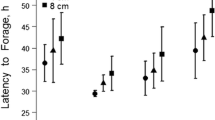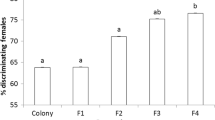Abstract
This study of pupation site selection was undertaken to assess the frequency and orientation of pupae making physical contact in four sympatric species in the family Drosophilidae: Drosophila melanogaster, D. simulans, D. funebris, and Zaprionus tuberculatus. Pupation behavior was assayed in a vial containing a small food cup. Using nearest-neighbor analysis, we found that pupae were aggregated. Furthermore, the frequency of contact between pupae was far greater than could be explained by chance, in all four species. In the three species of Drosophila, about a third of the contacts were between intimately paired pupae whose long axes were parallel; we call this arrangement synapsis. In Z. tuberculatus, most pupal contacts were unoriented. When D. melanogaster larvae were reared with each of the other species, heterospecific pupal contact, including synapsis, occurred. Our discovery of pupal contact in several drosophilids expands the known repertory of social behavior in this family.



Similar content being viewed by others
References
Ashburner M (1989) Drosophila A laboratory handbook. Cold Spring Harbor Laboratory Press, Cold Spring Harbor
Beltramí M, Medina-Muñoz MC, Arce D, Godoy-Herrera R (2010) Drosophila pupation behavior in the wild. Evol Ecol 24:347–358
Bodenstein D (1950) The postembryonic development of Drosophila. In: Demerec M (ed) Biology of Drosophila. Cold Spring Harbor Laboratory Press, Cold Spring Harbor, pp 275–367
Busto M, Lyenga B, Campos AR (1998) Genetic dissection of behavior: modulation of locomotion by light in the Drosophila melanogaster larva requires genetically distinct visual system functions. J Neurosci 19:3337–3344
Chess K, Ringo JM (1985) Oviposition site selection by Drosophila melanogaster and Drosophila simulans. Evolution 39:869–877
Connolly K (1968) The social facilitation of preening behavior in Drosophila melanogaster. Anim Behav 16:385–391
Crow JF, Kimura M (1970) An introduction to population genetics theory. Harper and Row, New York
Godoy-Herrera R, Silva-Cuadra JL (1998) The behavior of sympatric Chilean populations of Drosophila larvae during pupation. Genet. Mol. Biol. [Online].vol. 21 n.1 [cited 2011-11-10] Available from http://www.scielo.br/scielo.php?script=sci_arttext=S1415-47571998000100007&Ing=en&nm=iso>.ISSN 1415-4757. http://dx.doi.org/10.1590/S1415-47571998000100007
Godoy-Herrera R, Cifuentes L, Diaz de Arcata MF, Fuentes FM, Ryes I, Valderrama C (1989) The behavior of Drosophila melanogaster larvae during pupation. Anim Behav 37:820–829
Hall JC (2003) Aneurogeneticist’s manifesto. J Neurogenet 17:1–90
Hoffmann AA, Hallas R, Sinclair C, Mitrovski P (2001) Levels of variation in stress resistance in Drosophila among strains, local populations, and geographic regions: patterns for desiccation, starvation, cold resistance, and associated traits. Evolution 55:1621–1630
Jacobs M (1978) The influence of beta-alanine on mating and territorialism in Drosophila melanogaster. Behav Genet 8:487–502
Kojima K, Kimura MT (2003) Life history adaptations and stress tolerance of four domestic species of Drosophila. Entomol Sci 6:135–142
Krebs CJ (1989) Ecological methodology. Harper & Row, New York
Medina-Muñoz MC, Godoy-Herrera R (2005) Dispersal and prepupation behavior of Chilean sympatric Drosophila species that breed in the same site in nature. Behav Ecol 16:316–322
Mosteller F, Youtz C (1961) Tables of the Freeman-Tukey transformations for the binomial and Poisson distributions. Biometrika 48:433–440
Patterson JT, Stone WS (1952) Evolution in the genus Drosophila. Macmillan, New York
Ringo JM (1977) The influence of visual and olfactory stimuli on jousting behavior in Drosophila grimshaw (Diptera: Drosophilidae). Anim Behav 25:275–280
Ringo JM, Wood DF (1983) Pupation site selection in Drosophila simulans. Behav Genet 13:17–27
Rodriguez L, Sokolowski MB, Shore JS (1992) Habitat selection by Drosophila melanogaster larvae. J Evol Biol 5:61–70
Sameoto DD, Miller RS (1968) Selection of pupation site by Drosophila melanogasterand D. simulans. Ecology 49:177–180
Seyahooei MA, Kraaijeveld-Smit FJL, Kraaijeveld K, Crooijmans JBM, Van Dooren TJM, van Alphen JJM (2009) Closely related parasitoids induce different pupation and foraging responses in Drosophila larvae. Oikos 118:1148–1157
Siegel S (1956) Nonparametric statistics for the behavioral sciences. McGraw-Hill, New York
Simon AF, Chou M-T, Salazar ED, Nicholson T, Saini N, Metchev S, Ackerson LC, Maidment NT, Krantz DE (2012) A simple assay to study social behavior in Drosophila: measurement of social space within a group. Genes, Brain and Behavior 11, 243–252
Sisodia S, Singh BN (2010) Resistance to environmental stress in Drosophila ananassae: latitudinal variation and adaptation among populations. J Evol Biol 23:1979–1988
Sokolowski MB, Bauer SJ (1989) Genetic analyses of pupation distance in Drosophila melanogaster. Heredity 62:177–183
Sokolowski MB, Bauer SJ, Wai-Ping V, Rodriguez L, Wong J, Kent C (1986) Anim Behav 34:403–408
Wang JW, Soll DR, Wu C-F (2002) Morphological description of the wandering behavior in Drosophila larvae: A phenotypic analysis of K+ channel mutants. J Neurogenet 16:45–63
Whitlock MC (2005) Combining probability from independent tests: the weighted Z-method is superior to Fisher’s approach. J Evol Biol 18:1368–1373
Wilson EO (1975) Sociobiology: the new synthesis. Bellknap Press of Harvard U. Press, Cambridge
Yassin A, David JR (2010) Revision of the Afrotropical species of Zaprionus (Diptera, Drosophilidae), with descriptions of two new species and notes on internal reproductive structures and immature stages. ZooKeys 51:33–72
Zar J (1999) Biostatistical analysis, 4th edn. Prentice-Hall, Upper Saddle River
Acknowledgments
We thank Danny Segal for donating laboratory supplies and providing access to the Tel Aviv University library, Bill Glanz for his invaluable advice in the nearest-neighbor analysis, the Bloomington Drosophila Stock Center, Indiana University, for supplying Drosophila stocks, and AmnonFreidberg for confirming the identification of Zaprionus tuberculatus.
Author information
Authors and Affiliations
Corresponding author
Rights and permissions
About this article
Cite this article
Ringo, J., Dowse, H. Pupation Site Selection in Four Drosophilid Species: Aggregation and Contact. J Insect Behav 25, 578–589 (2012). https://doi.org/10.1007/s10905-012-9324-x
Revised:
Accepted:
Published:
Issue Date:
DOI: https://doi.org/10.1007/s10905-012-9324-x




